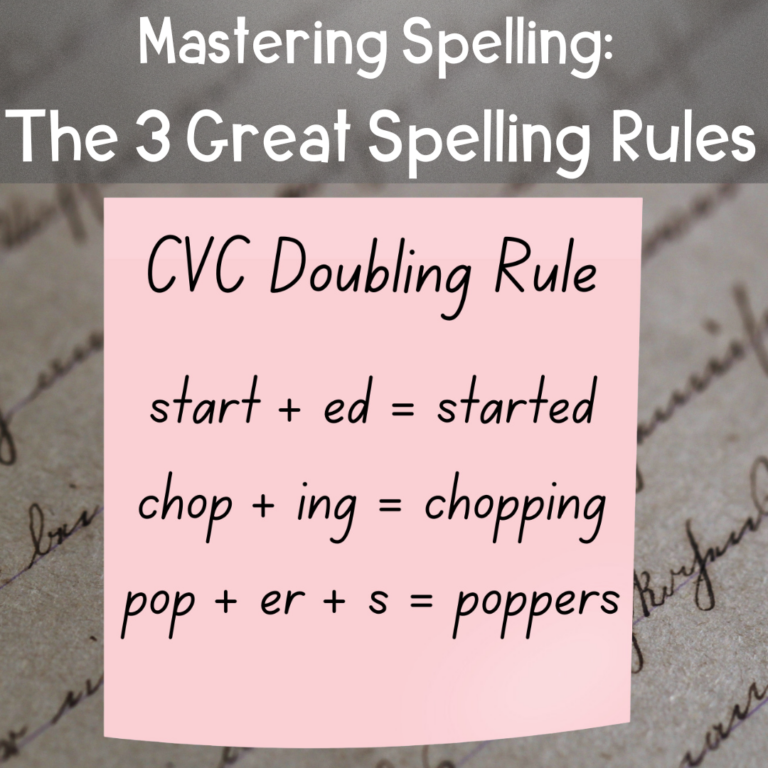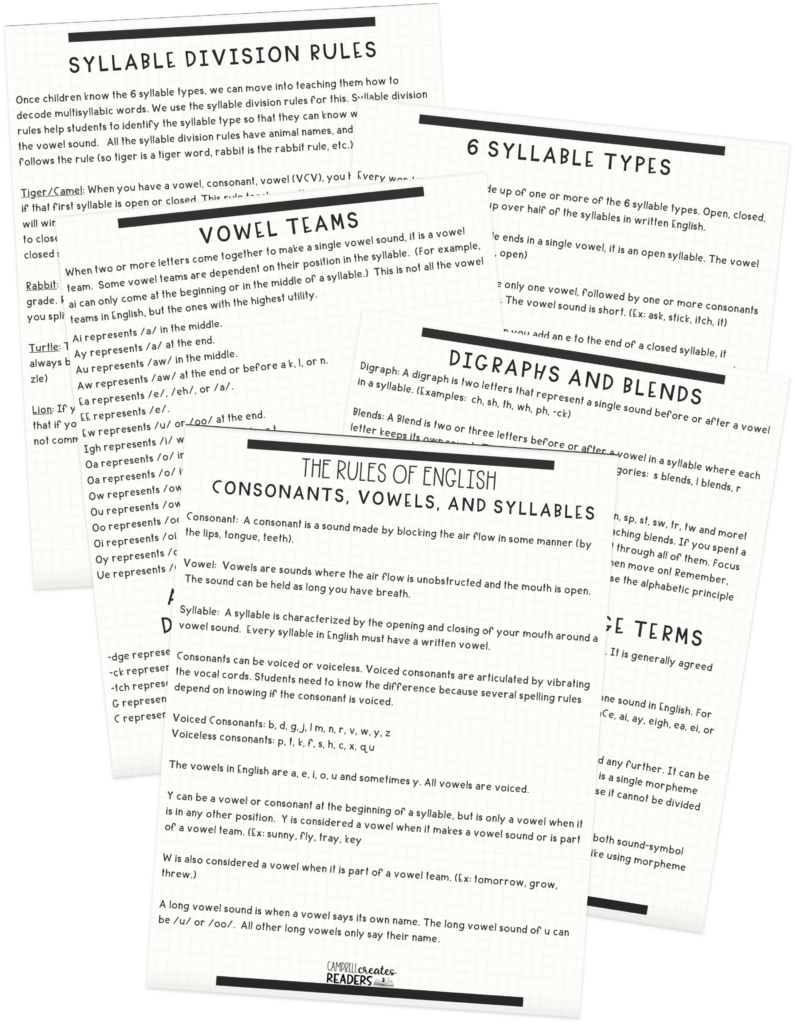
Share This:
Over the past few years, phonics has become the poster child for the structured literacy movement. After decades of being ignored, I think it was past time for phonics to be highlighted.
But we must remember that phonics is but one component of our reading instruction. And all the strands of Scarborough’s Reading Rope deserve attention.
So today, we’re going to talk about vocabulary. More specifically, I’m sharing an activity for upper elementary teachers that can help your students grapple with vocabulary daily, as well as help promote word learning strategies for when they come across unfamiliar words.
Vocabulary instruction is not as simple as explicitly teaching important vocabulary words, although that is certainly essential. Children learn 2-3,000 words a year once they enter formal schooling, and we simply cannot teach that many words. Most words students will learn in their lifetime come from the books they read. Graves notes that, over time, wide reading has the largest contribution to vocabulary development (2016). That tells me that when it comes to reading instruction, we have to both explicitly teach AND provide ample reading time for students to practice word-learning strategies.

Although we cannot teach our students 2-3,000 words a year directly, we can explicitly teach strategies and provide opportunities for students to improve their vocabulary. One way we can do that is with a vocabulary notebook. Let’s talk about the ways a vocabulary notebook can help students process meaning of words directly taught, as well as provide strategies for determining the meaning of unknown words.
Below, I’m providing three separate strategies that you can place inside a vocabulary notebook. These strategies focus on: daily writing to practice known words, morphology interactive notebooks, and context clues practice. The daily writing helps students to practice and process word meanings, while morphology and context clues are considered word-learning strategies.
You don’t have to complete all three steps every day. Perhaps you want to alternate between daily writing and context clues. I tend to introduce only one or two morphemes a week. This notebook is meant to be flexible to work for you and your students.
We know that in order for students to truly know a word and to help them reach a rich, decontextualized understanding of words, they must practice them a lot. Put another way, “it is essential that students repeatedly see, use, and review all new words”(Graves, 2016, p.50). And most of the time, this practice doesn’t happen with vocabulary instruction in elementary schools. Instead, we teach words, we test words, and then we move on to the next set of words to teach and test (look, I’m as guilty as anybody else).
What if instead, we asked students to work with the words we’ve taught them. Every single week.
I can think of few bell ringers more powerful than asking upper elementary students to write about words they’ve been taught. Not only does this ask them to know a word’s meaning, but it asks them to grapple with words in writing. And we all know, writing helps us become better readers.
For this activity, it is best to have the vocabulary words you’ve learned throughout the year displayed somewhere. You can use an alphabet chart that is blown up to poster size or even swap out your old “word wall” for a vocabulary wall. Either way, you want the words you’ve taught your students to be easily accessible.

Each day, pose a thought-provoking question that requires students to use one of your previously taught vocabulary words in their written response. The key is that the question should only be answerable if the student understands the word’s meaning and nuance. For example, if the word is dense, a daily question might be, “Would it be harder to drive in a dense forest or a sparse forest? Why?” Students must choose a side, justify their reasoning, and most importantly, use the word correctly in context. These daily prompts are quick, low-prep, and incredibly high-impact. They reinforce vocabulary in a way that’s personal, meaningful, and embedded in authentic language use. Over time, you’ll see students not only retaining more vocabulary, but actually owning it.
The length of the response is not as important as the quality of the response. You’re looking for complete sentences and an understanding of the vocabulary word, not an essay.
Ask AI to write your daily questions. Here’s a prompt you could use (alter to fit your needs): Please write 10 kid-friendly questions that are appropriate for 4th grade. Each question should include the word calamity, and students should not be able to answer the question without an understanding of the target word.
Here’s what Chat GPT gave me when I asked this exact prompt:
Understanding morphology isn’t just a cool party trick to impress your friends (don’t worry, I’m aware none of them are impressed and it’s weird I do this. Look, if they didn’t want me to explain the word parts of misanthropist, they shouldn’t have used such a cool word.) Instead, morphology is key to unlocking meaning in unfamiliar words. When children understand morphology, they have the tools they need to figure out a word well enough that meaning is not interrupted. It is what we call a “word-learning strategy” because it helps students learn independently, which harkens back to what Graves said about the role of wide reading in vocabulary development!
I could talk about morphology all day long, and there have been times when I’ve done as such. But for now, let’s just say this: when it comes to morphology, our entire goal is for students to learn about word parts well enough that they can use them when they are reading independently.

That’s where morphology interactive notepages within the vocabulary notebook become so powerful. It’s not just a place for students to record prefixes, roots, combining forms, and suffixes: it’s a tool for meaning-making. When students use the morphology pages in their notebooks, they’re not simply trying to remember how to spell mis- for a test on Friday. They’re using that knowledge to unlock the meaning of new words they encounter. Over time, this practice transforms morphology from something students know into something they use. The notebook helps bridge that gap between instruction and application, giving students repeated opportunities to analyze, connect, and internalize how word parts shape meaning.
I used to think about context clues in the vein of “This week we are going to learn about context clues,” and that was really it. I saw it as a skill I would teach and check off the list, but I never understood it well enough as a powerful vocabulary habit.
Context clues aren’t just a skill of the week. When we teach students to look for clues in a sentence that point to a word’s meaning, we’re helping them preserve comprehension when reading independently. The goal isn’t for students to ace a worksheet or correctly identify that the nonsense word in Baloney (Henry P.) means “pencil.” While that book is a fun way to introduce the concept, it’s just the starting point.
The real purpose of teaching context clues is so that when students meet an unfamiliar word that could trip up their comprehension, they can use the surrounding text to reason through it. Take this line from Outlander, one of my recent obsessions:
“Captain Randall said you were a most diverting woman. Quite an encomium from the Captain, you know. He hasn’t much use for women ordinarily, though they swarm over him.”
I don’t know what encomium means, but I can tell it’s something like a compliment because it’s unusual for this character to speak favorably of women. I may not know the exact definition, but I understand enough to keep reading with confidence. That’s what we want for our students: enough meaning to keep moving forward without losing comprehension.
Within the vocabulary notebook, this kind of thinking can become a quick daily routine. Each day, students can glue in a sentence strip containing one or two sentences with a bolded vocabulary word (or simply use a PowerPoint to display). These sentences can come from the books you’re reading together or ones you’ve written yourself. Students then look around the word for context clues, highlight or underline the words that helped them infer meaning, and jot down their best guess at the definition. It’s simple, authentic practice that turns context clues from a one-week mini-lesson into an everyday reading habit.

Use a prompt like this to get your context clues sentences written for you: I’m teaching my students how to use context clues to determine the meaning of unknown words. Can you create 10 kid-friendly sentences that include a bolded target word students can use to practice finding clues? Each sentence should have enough context for students to infer the meaning. Please include a mix of clue types (definition, example, synonym, antonym, or general sense). Write the sentences at a [insert grade level] reading level. Please use the following words [insert target vocabulary words].
I’ll be honest: the vocabulary notebook I just shared is still living in the realm of an idea. That’s not easy for me to admit, especially when I pride myself on sharing resources I’ve seen work in real classrooms. I’ve typed, deleted, and retyped this paragraph more times than I’d like to admit.
While I haven’t yet implemented this notebook in its entirety, every component included is grounded in research-based best practices for vocabulary instruction. These aren’t new or untested activities: in fact, I’ve used each of them individually in my own teaching. What I’m offering here is a way to bring them together into one cohesive, student-friendly tool. I hope that soon, I’ll be back to update this section with classroom-tested stories and specific examples of how it works for students.
Phonics may have taken center stage in recent years, but vocabulary deserves its spotlight too. When we help students understand how words work through daily reflection, morphology practice, and context clue exploration, we are giving them tools that last far beyond our classrooms.
A vocabulary notebook is more than a collection of words. It is a record of discovery, a place where students wrestle with meaning, test their understanding, and make language their own. It turns passive vocabulary instruction into active word learning.
If you decide to try this idea with your students, start small. Choose one routine, such as a daily question or a context clues sentence, and make it part of your week. Over time, those small moments add up to something big: students who see words not as obstacles but as invitations to think, connect, and understand more deeply.
Graves, Michael F. The Vocabulary Book: Learning & Instruction. Teachers College Press, 2006.
*As an Amazon Associate, I earn from qualifying purchases. Some links in this post are affiliate links, which means I may earn a small commission if you make a purchase, at no additional cost to you.
Share This:

Savannah Campbell is a K-5 reading specialist. She has taught her entire 12-year teaching career at the school she went to as a child. She holds two master’s degrees in education from the College of William and Mary. Savannah is both Orton-Gillingham and LETRS trained. Her greatest hope in life is to allow all children to live the life they want by helping them to become literate individuals.

Savannah Campbell is a K-5 reading specialist. She has taught her entire 12-year teaching career at the school she went to as a child. She holds two master’s degrees in education from the College of William and Mary. Savannah is both Orton-Gillingham and LETRS trained. Her greatest hope in life is to allow all children to live the life they want by helping them to become literate individuals.
Feeling overwhelmed with all the terminology out there? Want to know the key terms all teachers need to teach phonics? In this FREE Rules of English cheat sheet, you get a 5 page pdf that takes you through the most important terms for understanding English—you’ll learn about digraphs, blends, syllable types, syllable divisions, and move. Grab today and take the stress out of your phonics prep!
